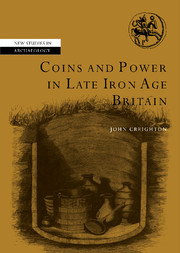Book contents
- Frontmatter
- Contents
- List of figures
- List of tables
- Preface
- Acknowledgements
- List of abbreviations
- Note on translations used
- Introduction
- 1 The Middle to Late Iron Age transition
- 2 Coin and the representation of individual authority
- 3 The Southern and Eastern kingdoms
- 4 Classical imagery and ideology in Britain
- 5 The location of Britain in the Roman world
- 6 Legends and language
- 7 Dynasties and identities
- 8 Conclusion and epilogue: from Britain to Britannia
- Appendix: A brief introduction to Iron Age coinage in Britain
- References
- Index of coin types
- General index
- NEW STUDIES IN ARCHAEOLOGY
2 - Coin and the representation of individual authority
Published online by Cambridge University Press: 22 September 2009
- Frontmatter
- Contents
- List of figures
- List of tables
- Preface
- Acknowledgements
- List of abbreviations
- Note on translations used
- Introduction
- 1 The Middle to Late Iron Age transition
- 2 Coin and the representation of individual authority
- 3 The Southern and Eastern kingdoms
- 4 Classical imagery and ideology in Britain
- 5 The location of Britain in the Roman world
- 6 Legends and language
- 7 Dynasties and identities
- 8 Conclusion and epilogue: from Britain to Britannia
- Appendix: A brief introduction to Iron Age coinage in Britain
- References
- Index of coin types
- General index
- NEW STUDIES IN ARCHAEOLOGY
Summary
If the relatively unranked Middle Iron Age gave way to individuals asserting dominance through the use of groups of loyal horsemen, then these new individuals would need to develop ways of validating and legitimising their new power and authority. Often this involves delving back into an imagined past: the Augustan revolution was legitimated as being a restoration of the Republic, though of course it was no such thing. This chapter investigates the ritual basis of authority, and introduces the discussion of the imagery on coin – one of the new media used to articulate authority.
The horse and the ritual basis of authority
Power and authority are rarely simply based upon might or the distribution of prestige goods. Frequently they are dressed up in ritualistic practices which help to validate authority. As Octavian took over the Roman state, he was very careful to use ritual and religion to consolidate his regime, even to the extent of taking on a new name, ‘Augustus’, with its religious overtones. We saw with the Sotiates of Aquitania that members of a comitatus could be bound by a sacred oath to their master. Rule and ritual are intertwined, but can we reconstruct any of it in MIA/LIA Britain? In order to investigate the ritual basis of kingship we will start with some analogies, separated in time and space from Britain.
- Type
- Chapter
- Information
- Coins and Power in Late Iron Age Britain , pp. 22 - 54Publisher: Cambridge University PressPrint publication year: 2000



